|
|
|
|||
|
|
||||
|
|
||||
| The (Jet)X Files | ||||
|
|
HOME | SITE MAP | FORUM | CONTACT |
|
||
|
ABOUT | MOTORS | MODELS | ARCHIVE | HISTORY | STORE | FAQ | LINKS
|
|
|
|
|
|
|||||||||||||||||||||||||||||||||||||||||||||||||||||||||||||||||||||
|
The (Jet)X Files 6
(June 2003)
by Roger Simmonds Reprinted from SAM 35 Speaks, June 2003 The flying season is now well underway, and I am preparing for the Shuttleworth Scale Model Weekend (July 26/27) and the SAM 35 Modelling Weekend (August 9/10). These meetings attract a good number of Jetex models, and I have been test flying some models, including a Fairey Delta 2 and two examples of the Leduc 021 (right). I shall have to resist the temptation to ‘fly these to destruction’ in order to have something impressive, if possible, for these meetings and for this year’s Peterborough MFC Flying Aces. This will be held on Sunday September 7, and has competitions for rubber, CO2 and electric power, and there will again be the interesting Rapier Triathalon Challenge. This is for any Keil Kraft model flown with rubber and rocket power, and as a chuck glider. There will also be the usual Jetex/Rapier duration and scale events. The early autumn weather can be perfect for small jets, and the Flying Aces attracts many of our own ‘flying aces’ who are happy to share and demonstrate their expertise. Last year Peter Smart won scale with a fine selection of models, and my MiG 15, having been kindly ‘tweaked’ by Richard Crossley, distinguished itself by catching a thermal and landing in the lake. I have surveyed some Jetex-related websites, but I know that many folk are not comfortable with the internet, and for those who prefer a real magazine I can recommend the Pssst Off newsletter from the US. This is a mine of information, old plans and reprinted articles, (including some from SAM 35 Speaks). Current and back copies are available from Roger Walthen Sr. 14569, Dublin Dr. Carmel Indiana 46033. |
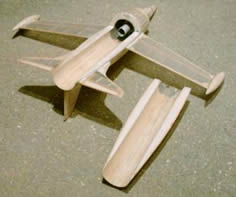
- Aeromodeller, Nov. 1953
|
|||||||||||||||||||||||||||||||||||||||||||||||||||||||||||||||||||||
|
After last month’s delve into our prehistory I have been looking for other rocket-powered models that predate Jetex. There was of course Howard Boy’s Flaming Ptero, and two innovative though somewhat alarming models from 1946/1947: the Glirt, Aeromodeller, November 1946), and the ‘Royston B Selwyn Rocket Plane’, whose story was told in SAM 35 Speaks, August 1999. Commercially produced rockets to power what was essentially a semi-scale Vampire were briefly available; the advertisement for the Astral kit reproduced on the right is from Aeromodeller November 1947. Obviously the early post war jet planes had made a great impact on the modelling imagination, and a safe, not to say legal, method of powering model jet aircraft was desperately needed. I wonder how these rocket motors (which were made by Brocks,) compare to the modern Rapier units. Peter Williams says they were similar to an L-2, and I would love to hear of any experiences with these earlier motors. We really do seem to have come ‘full circle’. This may make folk feel happier about using Rapiers! Last month I discussed the question of stability at some length. I think we can agree with Phil Smith that, even at best, our models have only marginal stability. Whilst this is a source of innocent amusement to bystanders, the poor flier may ask in frustration if the model is wayward because it hasn’t been trimmed properly and all wrinkles ironed out, or whether its unpredictability is an irreducible fact of (modelling) life. |

- Aeromodeller, Nov. 1947
|
|||||||||||||||||||||||||||||||||||||||||||||||||||||||||||||||||||||
|
|
|
|||
|
It could be argued that the flight pattern of some models is an example of ‘chaotic behaviour’, where minuscule differences at the beginning of a flight can lead to large deviations at its culmination (a phenomenon seen explicitly in the release of an air filled balloon!). A ‘good flight’ may be all too dependent on the speed and angle of launch, and wind strength and direction, and the actual motor thrust, none of which can be reproduced exactly. If we add to the equation the flexibility of airframes, slight deviations in the position of the motor orifice, the continuous acceleration, and a CG that is shifting throughout a flight, It must be concluded that it is remarkable we enjoy any successful flights at all. By “successful flight” is meant one that includes a gliding phase, however brief, though this should occur with the motor still attached to the model. Perhaps we are pusillanimous when trimming our models, but such is the apparent cost of motors that once an acceptable flight pattern is (sometimes) obtained, or the model appears intractable (and there are some examples), there is a big incentive to stop and not experiment further. This is understandable, though a pity, and explains why some of the more subtle arts of trimming rocket planes are being lost. |
||||
|
Even a Bell XS-1 can, I’m sure, be set up in different ways, by changing the rigging angles, or thrustline, CG, etc, but who except a rich masochist is really happy to explore the ‘flight envelope’ of their latest creation? However, if one is feeling bold, there are a number of designs with good flying characteristics that respond well to experimentation and can soothe nerves shattered by a more feisty prototype such as a Hunter, Sabre or Cutlass. The Bill Dean (Keil Kraft) MiG 15 shown right (sorry to keep going on about this one, but it really is such a good model) can be set up to fly well in a variety of ways, and for conditions from flat calm to breezy. One has to be prepared to ‘waste’ motors and perhaps damage the model in the process, but there is no other way, alas, to gain the experience necessary to respond creatively to an Aerographics Komet that loops continuously under power. We should do better than just add lumps of plasticine to the nose! I’m afraid flying small jet planes will never be easy, but by choosing a stable planform for our first scale masterpieces the pain can be minimised and confidence built up. |
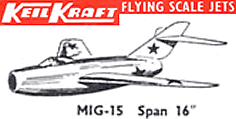
- Keil Kraft catalogue, c. 1960
|
|||
|
Perceptions of what design features make for a stable model have of course changed over the years. In the early Jetex days sweepback was treated with suspicion by some designers, though it was actually quite benign once it was realised that dihedral could be reduced. Conversely, large straight wing and shoulder mounted motor were reasonably expected to produce a nice stable flier, but these features have since proved to be anything but helpful. Phil Smith in the Aeromodeller Annual 1951, when discussing his model of the turbojet assisted sailplane, the (Veron) Fouga Cyclone (right) says, “the jet unit comes above the centre of resistance, creating a very stable flight set-up without tendency to spin […] a little model of this machine […] is perhaps more stable, both laterally and longitudinally than any other I have built. Although only powered by a Jetex 50, the span was 30" because of the high aspect ratio. A pal of mine flies his with a 100 unit and has great fun.” There was also a Dick Struhl design for the similar Fouga Cyclope, and there is no hint that this is a tricky design to trim, in fact a photo caption reads, “a simple butterfly tail eliminates the need for a rudder and is very simple to adjust”. The Cyclone is a most attractive model, and several experienced modellers have made adaptations for Rapier L-2 power with high expectations of a nice model (see Mike Stuart’s website). Strangely, this particular design, seemingly so promising, has proved almost impossible to trim, even when festooned with trim tabs on its (immovable) surfaces. |
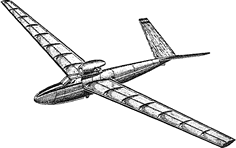
- Phil Smith

- Marty Richey
|
|||
|
A model with a similar planform, the Lockheed U-2 (right) has also proved all but intractable. Explanations for this that I have heard include the model being too small, a wing that is too thin and flexible, or has the wrong airfoil, or that the motor is too powerful and needs to come forward. It is a puzzle why the U-2, and especially the established Veron design, should prove so difficult for modern fliers. I know that the designer of a model can generally get the best out of it, and Phil Smith was something of a genius, but can any reader shed light on the matter? I will build a U-2 with stiff wings and elliptical dihedral (once, or even if, the plan arrives via US ‘snail mail’) and see if this helps. |
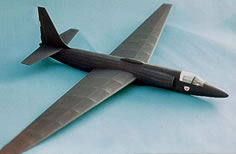
- Chris Strachan
|
|||
|
As we have seen, the twin boom configuration was thought promising from the first and there were two early, though not too accurate, Wilmot Mansour Vampires, one for the Jetex 50, the other for Jetex 100. There was I believe a Vampire from Tekniks in Sweden, but I haven’t yet found a plan for this; can any reader help? Both Keil Kraft and Skyleada produced kits of the slightly later Venom, and adaptations of these fly very nicely with Rapiers. The more recent Aerographics Flitzer (right) is an excellent introduction to Jetex scale that will fly ‘off the board’ if built accurately. Period plans of twin boom models include two for the rather tempting SIPA Minijet in Aeromodeller, August 1953, (for Jetex 100) and in |

- Richard Crossley
|
|||
|
The ready acceptance of the delta configuration for models is somewhat surprising. An explanation may be the seminal article on deltas by none other than Dr A M Lippisch (and Lawrence Conover) in Model Airplane News, December 1951 (right) and an equally erudite series of articles by John W Fozard in various Aeromodellers of 1953 and one in the Aeromodeller Annual of that year (pp. 110 ff.). The following extract from this comes after a discussion of CG position, and gives its flavour, which is typical of how people wrote in those days: “[It] is desirable to incorporate some degree of washout on a model delta. Models with washout have better stall characteristics […] 3º to 5º seems to be a good average figure with which to work. Dihedral appears to be unnecessary […] it seems desirable to keep the fin area as small as possible […] or otherwise to incorporate a long nose, since the delta shows a remarkable affinity for spiral instability.” This is wonderful stuff, and the delta, tailed, untailed or as a canard, was seen as a stable planform, uncritical in trimming and eminently suitable for rocket power. Modern experience confirms this, and deltas make a good first choice of scale subject. As an inducement there are numerous ‘virgin’ subjects, including a Hunter derivative, and the unique Sea Dart to complement your SARO A/1. |
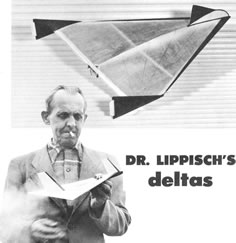
- Model Airplane News, Dec. 1951
|
|||
|
Classic flying scale designs such as the Vulcan (right) and Javelin fly very well with Rapiers; there is a Bolton Paul III (Aeromodeller May 1954), a really excellent YF-102 (Le Modèle Réduit d’Avion, August 1954), and an XF-92A (Model Airplane News, June 1957). There are also interesting duration models, including some from Dr Lippisch himself. The Dartex (Model Aircraft, March 1954) is typical of this genre. The Keil Kraft Avro 707A is a colourful and nostalgic subject, and a wonderful and realistic flier, evoking memories of its appearances at the Farnborough Air shows (see Nick Peppiat’s reduced version below right). Now this model has a comparatively thick wing of 11.4% thickness/chord ratio (t/c). In contrast, the majority of designs, whether scale or duration, have wing sections with of between 4-8% t/c which seem to work well at model sizes. A delta wing is more problematical if very thin, as might be the case, for example, with supersonic subjects. Wilmot Mansour had an ARTF delta ‘Interceptor Fighter’ for a Jetex augmented 50B. This kit is very reminiscent of the pre-war FROG offerings and the flying characteristics were obviously thought suitable for raw beginners. |
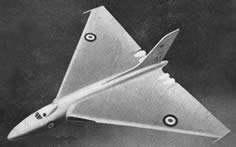
- Skyleada box artwork
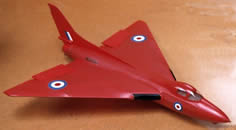
- Nick Peppiat
|
|||
|
Sebel, who took over Wilmot Mansour, produced a very classy ‘Tailored’ kit for the Fairey Delta 2 in 1956/57. Mike Ingram designed this model for an augmented 50B, and like the others in this series the level of prefabrication was high. The nose cone included in the kit is an early example of a moulded plastic accessory. As with the Starfighter discussed last month, I had some doubts that the F.D.2 ever reached the shops, because the plan I have is quite rough and lacks instructions. However, two correspondents have allayed my doubts about both models. Tony Crollie said he had a Starfighter as a lad for his birthday, though he can’t recall it ever flying, and Mike Mellor tells me he built a F.D.2, and “a wonderful flier it was too”. This is very pleasing. Unlike some of the other Tailored kits, the F.D.2 has a generous wing area of about 32 sq. in. (for a span just under 9"), whereas the Tailored Starfighter has just 19 sq. in. The wing loading of about 6 oz/sq ft (for a weight of about 1½ oz) is quite reasonable and similar to a Bell XS-1 of about 33-34 g (sorry about the mixed units, but it’s what I’m used to). However, Sebel did not make it that easy, and the wing is solid 1/8" balsa. If a model is heavy or the airfoil very thin the delta wing has to work at quite a high angle of attack (high alpha) with the subsequent high drag. This is not good for rocket power whose efficiency depends upon high speed and low drag. |
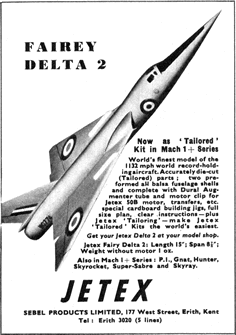
- RAF Flying Review, June 1955 (p. 50)
|
|||
|
Pete Smart has a very nice scratch built F.D.2 which really looks the part, having a very thin, though built-up, wing, and scale intakes open to the slipstream. I have heard it flies well with an L-2, and spectacularly with an L-2HP, though at high alpha, which may take away some of the realism, though not the excitement, of its flight. I had a surreptitious look at this model at last year’s Flying Aces, though alas I did not see it fly, and I thought I would try a slightly different approach. My F.D.2 (right) is the same size as Mike Ingram’s plan though I have increased the span to 10" and enlarged the area slightly to about 35 sq. in. The wing and fin are built up and there is some dihedral from the wing taper. |
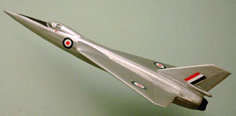
- Roger Simmonds
|
|||
|
The airfoil is thicker than scale (about 6% t/c) and I split the elevons to effect washout and aid trimming. After balancing and initial flight tests (see last month’s article) trimming at the flying field proved quite simple. It does need a faster than usual launch to get it ‘on the step’ (a catapult might be an option), but with 3° inner and 5° outer reflex, and a little left trim, it flies fast at a realistic angle of attack. The motor is forward of the CG, and towards the end of a flight the model climbs high in a spiral and then glides a surprising distance downwind. All this is very satisfying, and the lifting section and wing loading of under 4.5 oz/sq. in. (the model weighs under 30g with motor) contribute to the nice flying characteristics. However, the thicker than scale wing section required some enlargement of the air intakes (note that these are blanked off to reduce drag) so that they ‘looked right’ and I have not added fences. Good scale design always entails a compromise between ‘true scale’ features and adequate flying characteristics, and in my F.D.2 the delta wing is working as it should. But I’m not sure that I have captured the spirit or the prototype as well as either Pete’s model or the Sebel original that first inspired me. |
||||
|
The April copy of SAM 35 Speaks shows a picture of “Dr Simmonds’ Swift”. This is slightly disconcerting, not only because my cover has been blown, but also because the somewhat battered Swift, discussed in January’s column, belongs to my colleague Andy Blackwell, an inveterate collector of Jetex memorabilia. Before sensible renovation of this unique model (right) it seemed necessary to gain experience of models with enclosed motors, and try to recreate Tailored models de novo. Progress has been slow and I will share some experiences next month. |

- Andy Blackwell
|
|||
|
|
||||
|
|
|
|||
|
|
|
|
|
|
|
|
Acknowledgements - Article: Roger Simmonds - Illustrations: Roger Simmonds, Brian Benson, Andy Blackwell, Richard Crossley, MAAC archives via Bill Henderson, Nick Peppiat, Phil Smith, Chris Strachan |
|
|
|
|
ABOUT | MOTORS | MODELS | ARCHIVE | HISTORY | STORE | FAQ | LINKS |
|
|
Terms of Use
|
Queries? Corrections? Additions?
Please
contact us.
|
|